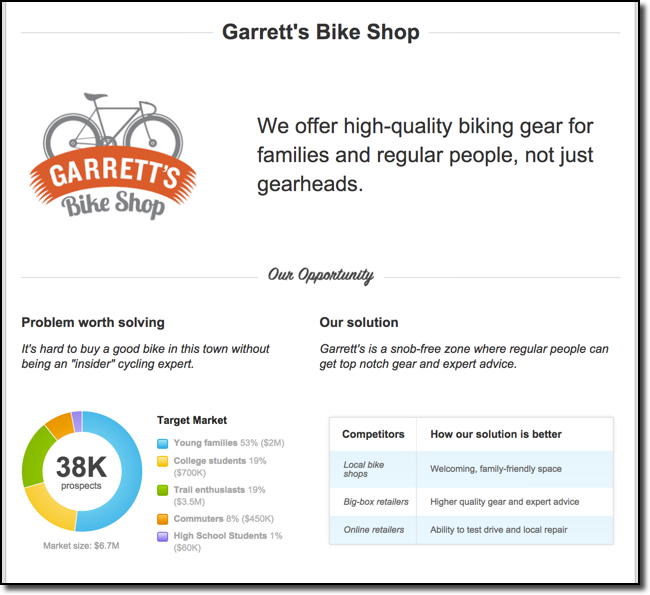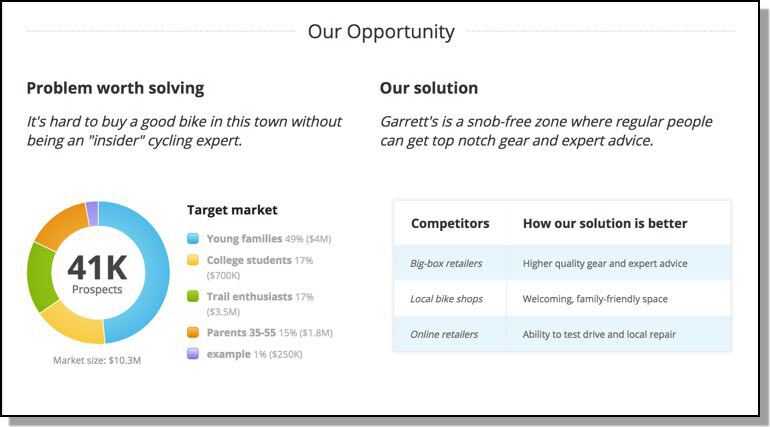
Get all your ducks in a row with an initial assessment of your business opportunity.
This article is part of our Business Planning Guide—a curated list of our articles that will help you with the planning process!
Start your business planning with a quick assessment.
Even an established business should take the time to step away from daily operations and look at the basics. Do your business numbers make sense? One of my business school professors used to refer to this process as finding out, “Is there a there there?”
There’s no single right way to do an initial assessment, and the words and phrases vary. My favorite is the Lean Business Plan, a collection of bullet-point lists and tables that lay out strategy, tactics, milestones, and essential numbers. People also like a one-page business plan, which is a really brief summary. For LivePlan users, the LivePlan summary is called the Pitch Page.
All of these are valid ways to approach assessing your business and its current health or potential viability; the difference is mainly a matter of preference. Focus on following through, keeping your eyes open, and being honest with yourself about what you find.
The Lean Business Plan
In its pure form, the Lean Business Plan is simple, just bullet points and lists and tables. Here’s a downloadable template: it’s a good alternative to the business model canvas. It includes a very simple definition of essential strategy, plus a list of tactics, milestones, and essential numbers.
Strategy is about focus and, in many cases, what you aren’t doing. What problem you solve, what solution you offer, your target market, and what makes you and your business qualified and different.
Tactics are the things you’ll do to achieve your goals, like the way you’ll talk about product benefits, how you’ll structure and test your pricing, methods for distribution, marketing activities, and so on. In a Lean Plan as a simple assessment, you keep this to simple lists.
Milestones are what is supposed to happen. Where do you start? What are the steps to follow? You answer these questions with a simple list.
Essential numbers or your financial plan might be simpler for an initial assessment than the projected sales, spending, and cash flow that are normally part of a Lean Business Plan. For an initial assessment, just do a sales forecast.
The one-page business plan
There’s really not much difference between a “one-page business plan, ” a Lean Plan, and a good executive summary. The only real possible difference is the that the “one-page plan” must absolutely fit on one page in a font that most people can still read, while a traditional executive summary can extend to two or three pages, but really should never be longer than that.
If you can condense your executive summary to one page, that’s great. Investors don’t have lots of time to read and a one-page executive summary will get the idea of your business across succinctly. It’s actually a very good exercise to reduce your executive summary to the absolute minimum. This will force you to trim needless words and communicate your business idea clearly and with minimal clutter.
The LivePlan summary
The LivePlan pitch page isn’t just about the pitch—it also serves as a strategy summary or an initial assessment. It’s a standardized one-page description including a logo, a short tagline, a market summary, bullet points for main business activities, a summary of financials, and the team.

Yes, I’m biased on LivePlan because it’s our product, but I see it used as a business summary now in the programs of several of the most prestigious business plan competitions, and my angel group is now using it to summarize some of the companies that submitted for our annual community event.
In my work on Lean Planning, I recommend that a Lean Business Plan includes just a brief strategy summary. That’s just a few bullet points for most people, but for LivePlan users I recommend using the LivePlan pitch. And I use it as a business summary, despite the name pitch page.
I can’t resist adding that LivePlan also includes some features designed to help with the real business pitch, the one I refer to as the pitch, the presentation for investors. It has graphics and summaries you can export as visuals for your slide deck for that first kind of pitch.
Market analysis
It’s hard to imagine an initial assessment that doesn’t include a market analysis. In the Lean Business Plan, it’s part of strategy, and it includes identifying your target market. Most one-page business plans include a brief market summary. So does the LivePlan Pitch. This section applies to any and all of them.
Whichever way you go with your initial assessment, determine if there is a sufficient market to support your business. You don’t need to do major market research for this initial market analysis. You may want, and even need, to do real research later on. For now, however, you want to get a good educated guess about how many potential customers you might have.
What you want at this point is a reality check. You’ve already developed a quick break-even analysis that ties your initial business numbers to your required sales. Now you’re going to look at how many customers you might have so you can think about the importance of breaking even.
Develop a basic market analysis table. This table gives you a simple list of market segments. Each segment is a group of customers. Define the groups according to what needs you supply, demographic characteristics, buying habits, preferences, or whatever other classification system works for your plan. Fill in the total potential customers estimated and the annual growth rate expected for each segment.
The following illustration shows a summary market analysis. You can also use a market analysis chart as a visual guide to your market segments.

Pause for reflection
Now it’s time to give your planning an objective appraisal.
At this point, you’ve defined your business, your financial break-even point, and your total potential market. How does your business look from this viewpoint? Does it make sense? Can you make the sales you need to break even? Is the market big enough? Are your projections realistic? Can you bring together the keys to success?
Especially for potential startup companies, a moment of reflection is critical. Many people dream of starting a business, but that dream turns into a nightmare if the new business isn’t successful. If you think you can make your break-even numbers work and you believe you have enough customers to make it, then go on to develop your full business plan. If not, either do more research and revise the idea, or give it up and try something else.
Short on time and need a business plan? Have an MBA write your business plan in five business days with LivePlan’s business plan consulting.
from Bplans Articles https://ift.tt/2qwIXcq

No comments:
Post a Comment